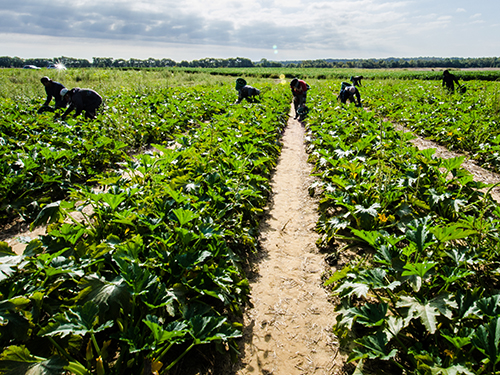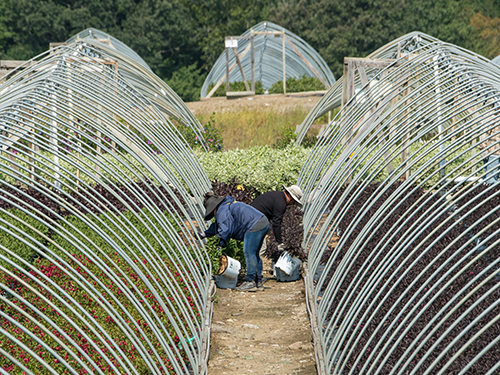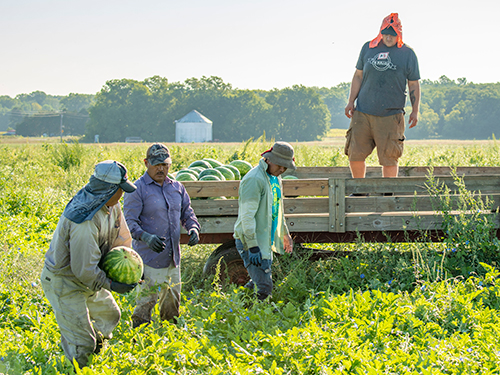
Fact Sheet FS747
Heat exposure can be a serious concern for agricultural laborers when working outside during the growing season. When a person's ability to adapt to heat stress is exceeded, exposure can lead to reduced productivity, mistakes in job performance, increased workplace incidents, and/or heat-related illnesses. Each person's heat tolerance varies and several factors including type of physical activity, fitness level, underlying health issues, and humidity can dramatically impact the potential for heat related injury. To determine the level of heat risk, employers should consider the job, the environment, and the worker. This fact sheet provides basic knowledge about heat stress, first-aid treatment, and preventative measures that are important to both employers and workers.
How the Body Responds to Heat
Sweat is the body's primary method to cool itself and maintain temperature in a narrow range between 97–99°F. Under certain conditions, sweating is insufficient to cool the body, and temperature regulation can be overwhelmed causing a rapid increase in body temperature. Heat stroke, for example, is a life-threatening condition that occurs when the body is unable to cool itself. The result may be a body temperature of 106°F or higher in a matter of only 10–15 minutes. Maintaining a safe body temperature is crucial to the well-being of those working outside. A balance must be struck between heat produced by a body at work and heat lost to or gained from the environment. The initial body response to heat is sweating and circulating blood closer to the skin surface to lower the main body temperature.
When extended heat exposure occurs, a physiological adaptation process called acclimatization occurs in response to increased temperatures. Acclimatization to heat may take weeks, although significant adaptation occurs within a few days of initial exposure. Once acclimatization is achieved, working in the heat results in increased production of a more dilute sweat (lower salt content) and less of an increase in heart rate and body temperature. The body's ability to respond to heat stress decreases with age, obesity, and other health-related factors. Older workers and obese workers are more vulnerable to heat-related illnesses and less capable of working safely in the heat. Pregnancy increases a woman's metabolic demands and may increase sensitivity to heat and humidity.
Other factors that may increase the risk of heat stress include sleep distress, poor physical condition, lack of acclimatization, dehydration, drug and alcohol use. Many commonly used over the counter and prescription drugs may also interfere with the body's response to heat stress. Preexisting medical conditions, such as cardiovascular disease, diabetes, certain skin disorders, and some diseases of the central and peripheral nervous systems, can impair people's normal physiological response to heat stress. Workers should consult their physician for more information concerning the above conditions.
Strategies For Worker Heat Acclimatization
To protect employees from heat-related illness, the following is recommended:
Methods of Heat Gain or Loss
Major physical processes by which the body gains or loses heat in a hot environment include:
- heat production by normal body functioning (metabolism)
- heat loss by evaporation
- heat loss or gain by convection and radiation (Metabolic heat gain is a by-product of both resting and physical exertion)
Evaporation is the cooling (heat loss) of the body that occurs when sweat evaporates from the skin's surface. The rate of this evaporative cooling is usually greatly increased by air movement across the skin with windy conditions outdoors or using fans. During strenuous activities in very hot environments, sweat production may equal one quart per hour; this amount of fluid loss by the body is usually sufficient to prevent overheating. Problems arise in warm humid environments, because humidity and still air interfere with the body's ability to dissipate heat. Sweat that cannot be evaporated from the body, but drips from the skin, will not result in body heat loss.
Convective heat loss or gain is the transfer of heat between the skin and surrounding air. When air temperature is higher than skin temperature, the body gains heat through convection. If air temperature is lower than skin temperature, the body loses heat. The rate of heat gain or loss depends upon the difference between air and skin temperatures and the presence of air movement (wind velocity). The use of fans to continually move cool air next to the skin and move away the air already warmed by the skin is a common method of body cooling.
Radiation is the direct transfer of heat from a hot object (the sun, hot equipment, a furnace, or a warm wall) to another cooler object, such as a human body, without heating the air in between. The greater the temperature of an object, the more radiation it emits and the warmer the person will feel.
Heat-Related Illnesses
Heat Stress
Heat stress occurs when the body builds up more heat than it can handle. High temperatures, high humidity, sunlight, and heavy exertion increase the likelihood of heat stress. Excessive heat can reduce concentration, increase fatigue or irritability, and increase the risk of workplace incidents.
Heat Rash
Heat rash is an early warning signal of heat stress. It is commonly associated with hot, humid conditions in which skin and clothing remain damp from unevaporated sweat. Heat rash may involve small areas of the skin or the entire torso. If large areas of skin are involved, sweat production is compromised, resulting in a decreased capacity to work in the heat. Even after the affected area of skin is healed, sweat production will not return to normal in those areas for as long as 4 to 6 weeks.
Preventive measures are aimed at reducing daily exposure to hot and humid conditions. If heat rash occurs, precautions must be taken to avoid skin infections. Treatments include properly cleaning the affected area and applying antimicrobial ointments to prevent infection. Keeping the skin clean and dry for at least 12 hours each day will help prevent severe heat rash.
Heat Syncope
Heat syncope is characterized by dizziness or fainting while standing still in the heat for an extended period. The condition results from blood pooling in the skin and lower body parts which decreases blood flow to the brain. The most serious aspect of heat syncope is it may cause injury or fall incidents. This is especially dangerous while operating machinery. Treatment consists of resting in a cooler environment. Prevention is based on acclimatization and avoiding long periods of immobility while at work.
Heat Cramps
Symptoms include painful cramps or spasms in the legs, arms, or abdomen. The person will probably sweat heavily. Spasms may occur during work or after work has ended and even when at rest. Heat cramps are often caused by a temporary fluid and salt imbalance during hard physical work in hot environments.
First-aid treatments for heat cramps include:
- Applying firm pressure or gently massaging the affected muscle
- Resting in the shade or a cool place
- Drinking small sips of clear juice, such as apple juice or sports drinks that contain electrolytes. Alternatively, salt water can be an option for heat related muscle cramping (one teaspoon of salt per quart of cool water; plain water should be used for those with heart or blood pressure problems).
Heat Exhaustion
Heat exhaustion results from the reduction of body water content or blood volume. The condition occurs when the amount of water lost as sweat exceeds the volume of water intake during heat exposure. Heat exhaustion usually develops after several days of exposure to high temperatures. A person with heat exhaustion may have some or all these signs or symptoms: heavy sweating; clammy, flushed, or pale skin; weakness; dizziness; nausea; rapid and shallow breathing; headache; vomiting; or fainting.
First-aid treatments for heat exhaustion include:
- Move the individual to a cool area.
- Place the person on their backs with their feet raised above the heart.
- Loosen clothing and apply cool, moist cloths to the body, and fan them to dissipate heat.
- Slowly administer sips of clear juice, such as apple juice or sports drinks that contain electrolytes or salt water (plain water for those with heart or blood pressure problems).
- Call a doctor, especially if the person faints or vomits.
Heat Stroke
Heat stroke is a medical emergency and may be life-threatening. The body may either lose its ability to regulate temperature, due to a failure of the central nervous system to regulate sweat control, or its normal heat-regulating mechanism may simply be overwhelmed. Heat stroke can result in coma or death.
Early signs and symptoms of heat stroke include:
A worker who becomes irrational, confused, or collapses on the job should be considered a heat stroke victim, and you should call 911 immediately. Early recognition of symptoms and prompt emergency treatment is key to aiding someone with heat stroke.
While awaiting the ambulance, begin efforts to cool the victim down by performing the following OSHA recommended first aid for heat related illnesses:
Preventing Heat Stress
Evaluate the Risk of Heat Stress
Monitoring the environmental conditions during work times to make management decisions for workers is an important part of preventing heat-related illnesses. Temperature is not the only factor in implementing heat stress management. Humidity is another important consideration. The heat index is a measure of how hot it feels when the relative humidity is factored in with the actual air temperature.
An environmental heat assessment should account for the following factors: air temperature, humidity, radiant heat from sunlight or other artificial heat sources, and air movement. OSHA recommends the use of wet bulb globe temperature (WBGT) monitor to measure workplace environmental heat. OSHA provides this link to calculate the WBGT for a specific location. There is also a NIOSH/OSHA Heat App for Android and iPhone devices that uses the Heat Index as a screening tool.
Management Suggestions for Enhancing Heat Tolerance
- Acclimatization (to heat) is a process of adaptation that involves a stepwise adjustment to heat over a week or sometimes longer. An acceptable schedule for achieving acclimatization is to limit occupational heat exposure to one-third of the workday during the first and second days, one-half of the workday during the third and fourth days, and two-thirds of the workday during the fifth and sixth days. The acclimatization procedure should be repeated if a person misses workdays after days off due to illness, vacation, or other reasons for missing one week or more of job duties.
- Fluid replacement. Provide adequate drinking water for all employees. Recommend to employees they drink plenty of water before work shifts, during work, and after work. Simply relying on feeling thirsty will not ensure adequate hydration. To replace the four to eight quarts of sweat that may be produced in hot environments, people require one-half to one cup of water every 20 minutes of the workday. Potable drinking water kept at a temperature of 59°F or less is recommended.
- Physical fitness is extremely important. The rate of acclimatization is a function of the individual's physical fitness. The unfit worker takes 50 percent longer to acclimate than one who is fit.
Increasing Safe Work Practices
To find management and guidance tools for determining whether to implement heat stress management plans refer to the CDC documents on Heat Stress and Work/Rest Schedules.
The following list of management options should be considered to prevent heat stress for workers:
- Limit exposure time. Schedule as many physical work activities as practical for the coolest part of the day (early morning or late afternoon). Employ additional help or increase mechanical assistance, if possible, to lighten individual workloads.
- Minimize heat exposure by taking advantage of natural or mechanical ventilation (increased air velocities up to 5 mph increase the rate of evaporation and thus the rate of heat loss from the body) and heat shields/shade when applicable.
- Take rest breaks at frequent, regular intervals, preferably in a cool environment sheltered from direct sunlight. Anyone experiencing extreme heat discomfort should rest immediately and be provided with first aid for heat stress.
- Wear clothing that is permeable to air and loose fitting. Generally, less clothing is desirable in hot environments, except when the air temperature is greater than 95°F or a person is standing next to a radiant heat source. In these cases, covering exposed skin can reduce the risk of heat stress.
- A buddy system may also be helpful. It depends on a fellow worker's ability to spot the early signs of heat stress, such as irritability, confusion, or clumsiness. A ready means of cooling should be available in work areas where heat illness might occur.
Worker Health and Education
- Periodic medical examinations may help identify those workers who are at greater risk for heat-related illnesses. This is particularly important for those with preexisting health conditions or older workers.
- Drugs may alter the body's ability to deal with heat stress effectively. Health-care providers can provide important information about possible concerns and make recommendations about safe work practices.
- Alcohol use should be avoided before or while working in a hot environment.
- Worker health and safety education. All agricultural workers exposed to hot environments should receive basic instruction on the causes, recognition, and prevention of the various heat illnesses. Displaying educational posters in multiple languages throughout communal areas can help reinforce training.
References
This publication is based on the original work of Wei Zhao, Project Director of Agricultural Safety and Health Program, in consultation with Ann L. Kersting, and was initially made possible in part by a grant from the National Institute for Occupational Safety and Health Program on Agricultural Health Promotion Systems for New Jersey.
May 2024
Copyright © 2025 Rutgers, The State University of New Jersey. All rights reserved.
For more information: njaes.rutgers.edu.
Cooperating Agencies: Rutgers, The State University of New Jersey, U.S. Department of Agriculture, and Boards of County Commissioners. Rutgers Cooperative Extension, a unit of the Rutgers New Jersey Agricultural Experiment Station, is an equal opportunity program provider and employer.



